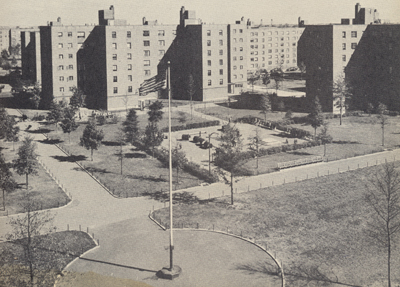The mayor wants to remake Los Angeles into something like ... 700 square miles of housing projects.
Los Angeles' mayor wants to take the city from concrete and scattered small buildings to a planned community of high-rise buildings and plenty of parks.Antonio Villaraigosa told the Los Angeles Times he has a vision for the city's future where neighborhoods are connected by an enlarged subway system, where the concrete channels that used to run storm water to the ocean will be torn up and replaced with park space.
He visions more museums, restaurants and shops, high-rise offices and apartments and what he calls 'stylish density' for the people living in the country's second most populated city.
There's a terrific precedent: New York in the 1950s. The city's perennial Utopian socialist cranks were at the apex of their power, and in the name of slum clearance they developed a scheme of housing that would, er, take the city from concrete and scattered small buildings to a planned community of high-rise buildings and plenty of parks.
You can still see the results. Throughout the city are whole so-called neighborhoods of tower blocks, with "parks" scattered among them, like those in the period photo (1955) above. The planners' city of dreams.
A funny old thing happened, though. No one who could afford to live in one of the decent "scattered small buildings" or move to the 'burbs would let so much as their shadow fall in the new "planned" high rises. Doubtless, for the first few years, some of the poor inhabitants who gravitated to them did believe they had come up in the world. But the sociological causes dear to the heart of New York's Liberal Establishment -- unlimited immigration, welfare, soft-on-crime judges -- that were changing the city saw to it that the projects (once, believe it or not, the word had positive connotations) turned into grim, alienating freelance penitentiaries. The "parks" made possible by highrising the inmates were best avoided by those who preferred not to be mugged, raped, or murdered.
True, Mayor Villaraigosa doesn't say he favors New York style housing projects. But Los Angeles developers are already putting up high rise condominiums, wherever the zoning laws will allow it, for affluent residents. So the mayor's plan sounds like a pitch for massive subsidized housing. What he can't say -- in public -- is, "We need towers to where we can install the two or three million more Mexicans that will lock in Los Angeles for la reconquista."
What about those amenities, 'mmm?
Well, parks or their cousins, urban open space, are the sucker bait that every developer offers to get approval for their colossal schemes. But somehow open space and high rises don't work together, even in upscale areas. They tend to become rubbish-strewn wind tunnels unpopulated except by moping teenagers. I'm not sure why; maybe people who live on the 25th floor just stop thinking about the ground as a place to spend part of their leisure time. London has urban squares graced by green space, built by developers in the 17th and 18th centuries, such as Bedford Square, St. James's Square, Berkeley Square, and the terraces surrounding Regent's Park. Those are still considered highly desirable locations. But they are mostly centerpieces of low-rise architecture. There's a human relationship between the houses and the open space.
It's almost impossible to design urban parks that attract people when the parks are surrounded by modern, sterile ugliness. Jane Jacobs, the famous urban architecture writer, noted that people from the streets of the upper West Side in New York congregated in narrow traffic islands in the center of Broadway, where there are few sculptures, fancy paving, or other whims of park designers, and plenty of noise and exhaust smoke. But there is a sense of connection with the city and the neighborhood, which is missing in purpose-built recreational areas like those between high-density slabs.
An enlarged subway system? For Los Angeles? As the hyena said in a rare serious moment, don't make me laugh. Subways and buses make some sense in downtowns and old, relatively compact eastern cities, but even in those places they are becoming increasingly obsolete as much of the commuting and travel is neither within downtown or between suburbs and downtown, but between suburbs and between "edge" cities on the periphery. Los Angeles, and other western cities, are so decentralized that no public transportation system conceivable could get people from any point to any point efficiently.
Even if Mayor Villaraigosa's loony notion had anything to recommend it, how could it be accomplished except through a wholesale abolition of property rights and a government agency with the authority to ... well, to do anything it liked to the city? Not to mention moon-shot financial resources?
Oh, yes. "He's looking to state and federal coffers to fund the subway expansion too," says the article. What a delicious mantra for a city politician. State and federal funding. State and federal funding. State and federal funding. Pie-in-the-sky-scrapers for millions of new immigrants. Contracts of all sorts for the Anglo business interests to keep them from squawking about being annexed by Mexico. The future's so bright, Hizzoner's gotta wear shades.


1 comment:
I think those Robert Moses tower in a park concept would work better with some ground level retail.
Any word of such a retro fit?
wwwfsbushs.blogspot.com
wwwtripwithinthebeltway.blogspot.com
Post a Comment